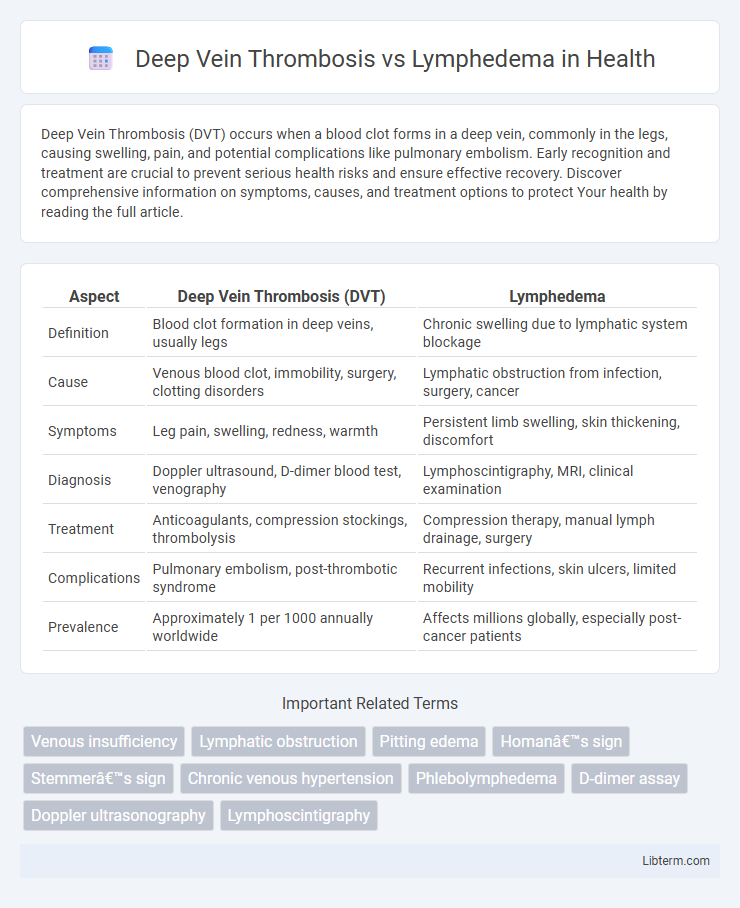Deep Vein Thrombosis (DVT) occurs when a blood clot forms in a deep vein, commonly in the legs, causing swelling, pain, and potential complications like pulmonary embolism. Early recognition and treatment are crucial to prevent serious health risks and ensure effective recovery. Discover comprehensive information on symptoms, causes, and treatment options to protect Your health by reading the full article.
Table of Comparison
| Aspect | Deep Vein Thrombosis (DVT) | Lymphedema |
|---|---|---|
| Definition | Blood clot formation in deep veins, usually legs | Chronic swelling due to lymphatic system blockage |
| Cause | Venous blood clot, immobility, surgery, clotting disorders | Lymphatic obstruction from infection, surgery, cancer |
| Symptoms | Leg pain, swelling, redness, warmth | Persistent limb swelling, skin thickening, discomfort |
| Diagnosis | Doppler ultrasound, D-dimer blood test, venography | Lymphoscintigraphy, MRI, clinical examination |
| Treatment | Anticoagulants, compression stockings, thrombolysis | Compression therapy, manual lymph drainage, surgery |
| Complications | Pulmonary embolism, post-thrombotic syndrome | Recurrent infections, skin ulcers, limited mobility |
| Prevalence | Approximately 1 per 1000 annually worldwide | Affects millions globally, especially post-cancer patients |
Introduction to Deep Vein Thrombosis and Lymphedema
Deep Vein Thrombosis (DVT) is a medical condition characterized by the formation of blood clots in deep veins, primarily in the legs, which can lead to serious complications like pulmonary embolism. Lymphedema involves the chronic swelling of limbs due to lymphatic system obstruction or damage, causing fluid retention and tissue swelling. Both conditions require early diagnosis and targeted management to prevent progression and improve patient outcomes.
Understanding Deep Vein Thrombosis (DVT)
Deep Vein Thrombosis (DVT) is a condition characterized by the formation of a blood clot in a deep vein, often in the legs, which can cause swelling, pain, and redness. Unlike lymphedema, which results from lymphatic system obstruction leading to fluid retention, DVT involves venous blood flow disruption and poses risks such as pulmonary embolism if untreated. Early diagnosis through ultrasound imaging and anticoagulant therapy is crucial for managing DVT effectively and preventing complications.
What is Lymphedema?
Lymphedema is a chronic condition characterized by swelling in the limbs due to impaired lymphatic system function, often caused by lymph node removal, radiation therapy, or infection. Unlike Deep Vein Thrombosis (DVT), which involves blood clot formation in deep veins, lymphedema results from the accumulation of lymphatic fluid leading to persistent edema and tissue fibrosis. Early diagnosis and management with compression therapy, exercise, and meticulous skin care are essential to prevent complications and improve patient outcomes.
Key Differences: DVT vs Lymphedema
Deep Vein Thrombosis (DVT) primarily involves the formation of a blood clot within deep veins, often in the legs, leading to swelling, pain, and risk of pulmonary embolism. Lymphedema results from impaired lymphatic drainage causing chronic swelling, usually in limbs, without the immediate clotting risk seen in DVT. Unlike DVT's acute onset and potential life-threatening complications, lymphedema is typically a long-term condition characterized by tissue fibrosis and recurrent infections.
Causes and Risk Factors: DVT and Lymphedema
Deep Vein Thrombosis (DVT) is primarily caused by blood clot formation in deep veins, often linked to prolonged immobility, surgery, and inherited clotting disorders. Lymphedema results from impaired lymphatic drainage due to lymph node removal, radiation therapy, infections, or congenital abnormalities. Risk factors for DVT include obesity, smoking, and age over 60, while lymphedema risk is heightened by cancer treatments, chronic infections, and trauma to the lymphatic system.
Common Symptoms and Clinical Presentation
Deep Vein Thrombosis (DVT) typically presents with unilateral leg swelling, pain, warmth, and redness, often accompanied by a tender, palpable cord along the deep veins. Lymphedema manifests as chronic, non-pitting edema, primarily affecting the distal limbs, with skin thickening and a "peau d'orange" texture, without the acute warmth or erythema seen in DVT. Both conditions cause limb swelling, but DVT's sudden, painful presentation contrasts with the gradual, painless progression of lymphedema.
Diagnostic Approaches for DVT and Lymphedema
Diagnostic approaches for Deep Vein Thrombosis (DVT) primarily involve duplex ultrasonography, which combines traditional ultrasound and Doppler flow analysis to detect blood clots in deep veins. In contrast, lymphedema is diagnosed through clinical evaluation and imaging techniques such as lymphoscintigraphy and magnetic resonance lymphangiography, which assess lymphatic system function and fluid accumulation. Blood tests for D-dimer levels are also frequently utilized in ruling out DVT, while lymphedema diagnosis relies heavily on patient history and physical examination to distinguish it from other causes of limb swelling.
Treatment Options for DVT vs Lymphedema
Treatment options for Deep Vein Thrombosis (DVT) primarily include anticoagulant medications such as warfarin or direct oral anticoagulants (DOACs) to prevent clot growth and reduce the risk of pulmonary embolism, alongside compression stockings to improve venous flow. Lymphedema management focuses on complex decongestive therapy (CDT), which involves manual lymph drainage, compression bandaging, exercise, and meticulous skin care to reduce swelling and prevent infection. In severe cases, surgical interventions like lymphatic bypass or vascularized lymph node transfer may be utilized for lymphedema, while thrombolytic therapy or inferior vena cava filters are options for refractory DVT cases.
Prevention Strategies and Lifestyle Modifications
Effective prevention strategies for Deep Vein Thrombosis (DVT) include regular physical activity, maintaining a healthy weight, and avoiding prolonged immobility, especially during long flights or bed rest. Lymphedema management emphasizes consistent skin care, compression therapy, and gentle exercises to enhance lymphatic drainage while preventing infections. Both conditions benefit significantly from lifestyle modifications such as quitting smoking, staying hydrated, and monitoring for early symptoms to reduce complications and improve overall vascular health.
When to Seek Medical Attention
Persistent swelling, pain, and redness in the legs may signal Deep Vein Thrombosis (DVT), requiring immediate medical evaluation to prevent complications like pulmonary embolism. Lymphedema presents as chronic, non-painful limb swelling and skin changes, necessitating prompt consultation for effective management and to avoid infection. Seek emergency care if symptoms include sudden chest pain, difficulty breathing, or rapid heart rate alongside leg swelling, indicating potential DVT complications.
Deep Vein Thrombosis Infographic

 libterm.com
libterm.com